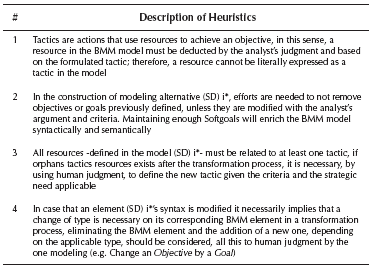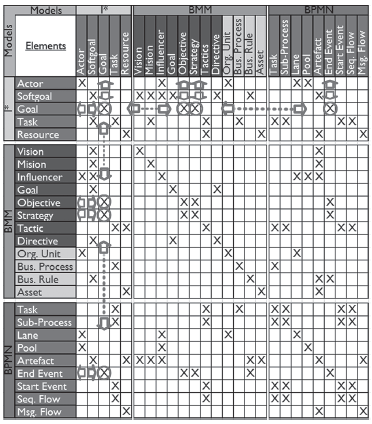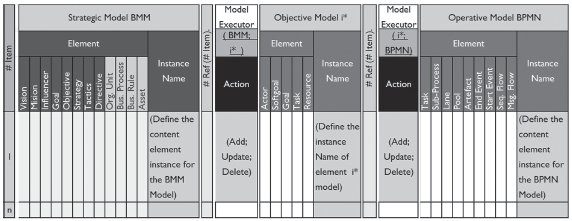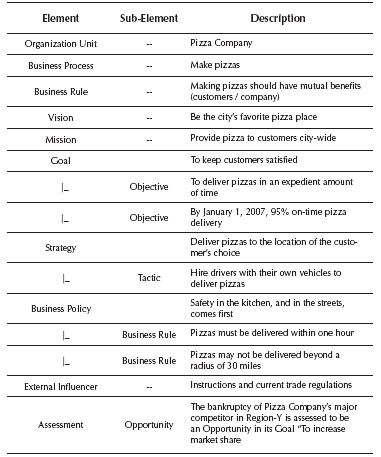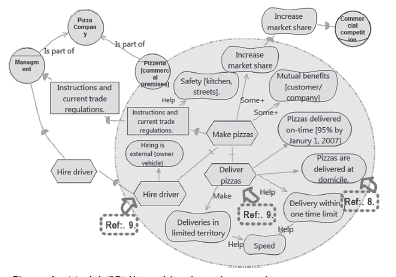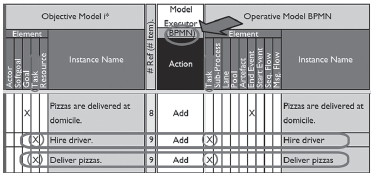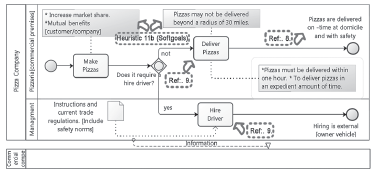Introduction
Often, companies of any size and economic capacity define from its beginnings the visionary and basic concepts necessaries for its constitution; during this process, companies include motivational elements such as vision, mission and projection of objectives. As time passes and in a natural process, organizations' strategy and processes tend to lose synchrony. This is mainly caused by a market's active dynamic or the organizations own management of the business' context, which in turn produces a continuous evolution of its processes.
Consequently, finding diverse alternatives to achieve a greater alignment between strategy and business processes constitutes a challenge and a priority for the development of the strategic and operative components within the framework of an enterprise architecture - EA (Goethals et al., 2006; Lankhorst et al., 2005).
Our proposal complements in several aspects some previous and independent work in the domain of alignment between strategic and operational models (Alves et al, 2013; Bleistein et al., 2006; Cravero 2012; Koliadis et al., 2006). We have contributed to the state of art in the paradigm of the strategic - operational alignment. We defined an integral methodology that will allow the tasks of modeling and bi-directional alignment among different levels of abstraction to be optimized in a practical manner.
In the beginning, organizations use BMM (OMG: BMM, 2015) to define the organizational strategy (motivation) and BPMN (OMG: BPMN, 2013) to model business operations. The correspondence between the two models is not evident and sometimes "ad hoc" methods that don't allow reutilization or generalization are used. In this context, in order to reduce the natural gap between the motivation and the operational abstraction levels, a modeling agent-goal paradigm called i* (Yu, 1995) is used. To establish a bidirectional correspondence between these models, we have classified, unified and contributed transformation heuristics between the goals model and the operational one by complementing some previous works (Bleistein et al., 2006; Alves et al., 2013).
Furthermore we developed transformation heuristics between the BMM and i* models, transformation heuristics between the i* and BPMN models, and some additional and specific mapping heuristics between the strategic model and the goal model. Some specific theories of transformation among the strategy and the operation were formed. In addition, we developed some support artifacts (Matrix mapping between constructs, Overview of the Matrix log of alignment) for tracing and controlling the alignment between these models.
Research Context
We have based our work on strategic - operational alignment paradigms, which are current and adopted in most organizations that focus its efforts in the area of the EA. Among them, we can mention the strategy orientated paradigm, that contains modeling oriented by goals and agents (Yu, 1997) and whose goal-oriented and agent-oriented approach have been important in the field of requirement engineering (RE). Therefore, frameworks that share this concept such as NFR (Chung et al., 2000), KAOS (Bodhuin et al., 2004) and GRL (Amyot & Mussbacher, 2002; GRL, 2016) have demonstrated significant advantages in organizational impact during strategy modeling.
One of the framework derived from strategy-oriented paradigm is called i* (Yu, 1995), which allows modeling organizational goals and the relationship between the ones that are responsible for the organization, adopting an approach of the intentional domain y socio-technical. i* is normally used to model and understand the internal relationships and the external environment of an organization. This includes actors, goals and responsibilities of dependencies and alternatives (Horkoff and Yu, 2009). i*'s methodology includes: the Strategic Dependence model (SD), which describes how stakeholders depend on each other inside an organizational context; the Strategic Rational model (SR), which mainly describes stakeholder's interests and concerns by means of intentional elements such as goals, soft goals, tasks and resources, as well as particular dependencies with other elements inside the organizational context (Yu, 1995).
On the other hand, there are interesting works such as Yu et al. (2006); Cravero et al. (2009); and Cravero, (2012) illustrating the potential use of BMM together with i* supporting intentional modeling and Enterprise Architecture (EA) analysis under different perspectives.
The Business Motivation Model (BMM) focuses primarily on modeling intentionality thus providing a framework for developing, communicating and managing business plans in an organized way (BGR, 2016). This structured meta-model introduces elements and intentional interrelationships, this includes: the ends, describing the aspirations of the company, the means defining plans the company utilizes to achieve those ends and the tactics and strategies to be implemented to fulfill those purposes. The model includes so called influencers, those elements that can positively or negatively impact the organization's operation, means and ends (Collazos & Duarte, 2016).
Additionally, BMM model has referenced four relevant concepts: Asset, Organization Unit, Business Process, and Business Rule; which have roles in BMM structure but actually belong in other standards OMG, where they are defined. Also, for construction of BMM model, techniques such as VMOST (Bleistein et al., 2006) and VMOST Extended (Collazos & Duarte, 2016), can be considered as semi-structured tools to define the business strategy.
Another one of the paradigms that we address in this work, related with the strategic - operational alignment, aims to reduce the natural gap in the level of abstraction that exists between the strategic model and the operative model of business processes. Under this concept, in addition to strategic modeling, efficient operations design and modeling of business processes with its corresponding implementations are also treated as significant. It is here where the BMPN modeling standard serves as a common language, easy to interpret, for modeling business processes in a graphical manner.
In relation with this work, the literature presents specific cases such as those as described by (Bleistein et al., 2006; 2006 (b)), in which the strategy of an organization is represented through the i* goals and BMM models, distinguishing the business level above the information technology (IT) level with the objectives level, and establishing the correspondences between them. This approach differs from our work on the goals and in the omission of a context focused on strategic and operative alignment using BPMN to define the operational business model.
Although, the literature shows us some proposals that try to independently integrate strategy with the goal model (Cravero et al., 2009; Cravero, 2012), and others based in i*'s goal model and BPMN (Alves et al., 2013; Koliadis et al, 2006), we consider that our proposal is more complete and structured since we've supplemented it with new heuristics that can enables the passage between the different levels of abstraction and the introduction of new artifacts that make the alignment process more practical.
Methodological Alignment Proposal
Some authors like Reich et al., (1996); Luftman, (2000); Theve-net, (2006) state that an "alignment" takes place when information technologies (IT) are being applied correctly and opportunely, working in synergy and harmony with strategy and operations to achieve IT's own goals, and satisfy the organizational needs.
Our approach based on heuristics (Reeves, 1996) and (Manie-ga, 2010) complement some previous works based in this concept (Koliadis et al. , 2006; Alves et al., 2013); here we have focused on classifying the elements of the models extending some of the heuristics. This allow us to propose a methodology that applies an integral vision of mappings, transformations and actions to bear in mind in the alignment process using BMM, i*'s goal model and BPMN.
Below, we present the heuristic proposed to bear in mind in the alignment process between the different levels of abstraction, obtaining concrete guidance for processing and aligning each model's elements.
Heuristic of Transformation between models BMM and i * :
Table 1 shows the key heuristics, in the identification of the goal model i* from the elements of the model BMM and vice versa.
Table1 Transformation heuristics between BMM and i* models
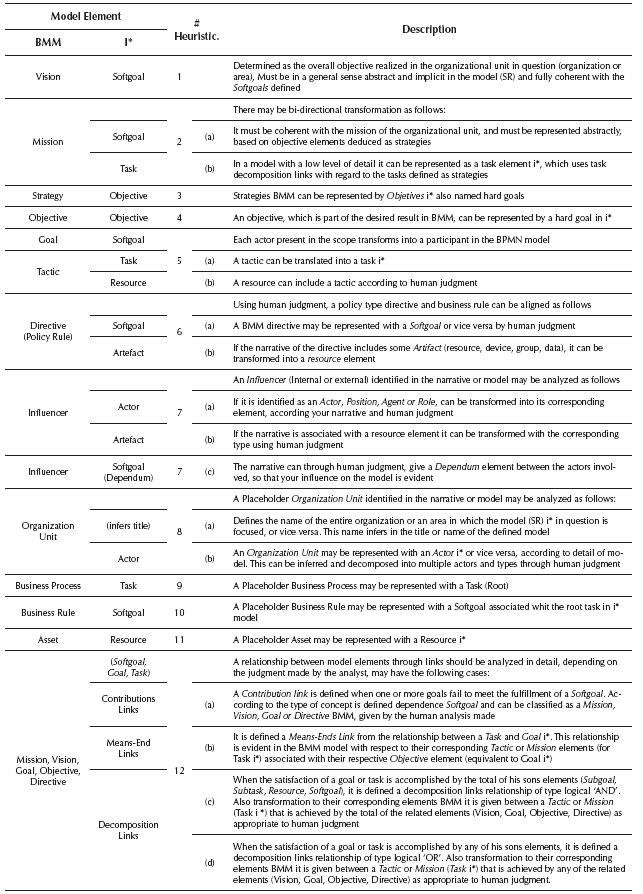
Source: Authors based on (Bleistein et al., 2006; Cravero et al., 2013).
The alignment, in principle, can mostly be deduced by the analyst (Horkoff, 2006). This transformation allows to reduce the gap that exists between the abstracts levels strategic and operational. Here our additional contribution by heuristics: 6 (b), 7-12.
Heuristics Mapping between the models i * and BPMN In comparisons analysis and mappings of elements between strategic and operational models, numerous proposals have evolved (Alves et al., 2013; Fuxman et al., 2004; Giorgini et al., 2004; Koliadis et al., 2006). Those proposals described the possible ways to align goal and operational models systematically. During this mapping procedure, it is important to specify the routines and define their scope (Koliadis et al., 2006; Yu, 1995). Heuristics adopted and in this work have been consolidated, classified and extended, allowing the determination of existing consistencies between models i* and BPMN, as expressed in Table 2. Here our additional contribution by heuristics: 11(b, c).
Table 2 Transformation heuristics between i* & BPMN models
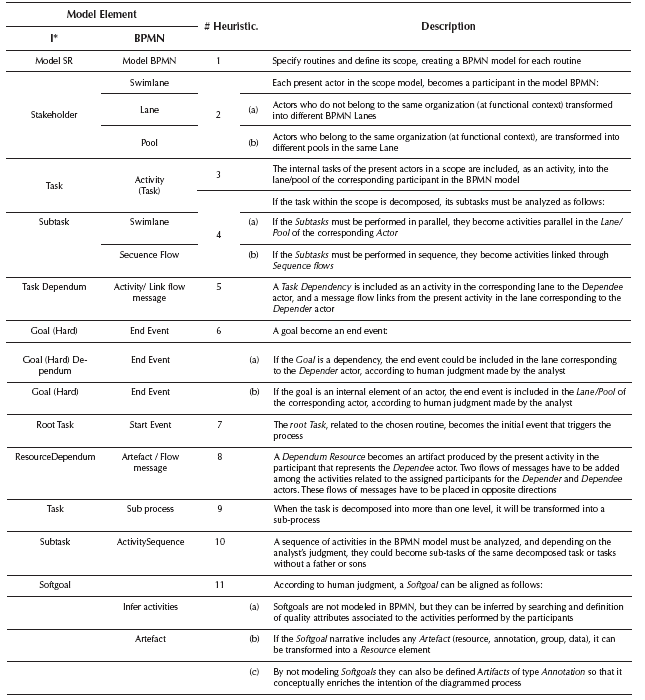
Source: Authors, based on (Koliadis et al., 2006; Alves et al., 2013).
Other Heuristics of i * Transformation towards BMM. During this proposal development, the proposal of some additional heuristics have been considered that might be taken into account during the transformation process, specifically, from the i* model towards BMM. This will allow the one modeling to cut time in strategic synchronization, optimize the alignment procedure of the motivational model with the objective model, besides enriching mutual, syntactically and semantically its elements. This corresponds to Table 3.
Support artifacts in the alignment
According to the views expressed by Karunakaran & Purao (2012), artifacts such as templates represent certain processes' materials, which can facilitate their execution. This motivated us to build some concrete artifacts like matrices and templates as a guide for the alignment procedure and synchronization of the strategic and operational models. This approach, as a constructor under the design science paradigm (March and Smith, 1995) also has been adopted in others proposals (Collazos & Duarte, 2016).
Matrix mapping between constructs and its elements
During the alignment procedure between BMM, i* and BPMN, the need to optimize the way referencing their basic elements between each other arises. Thus, we have designed a transposed matrix (At) of symmetrical type (nxn) (Grone et al., 1987), applying concepts of Toeplitz and Hankel matrices (Ikramov & Chugunov, 2016), that allows the mapping between the models and their basic elements wherein, for each one and doing its transposition, will always give us the same result guaranteeing that the search and alignment with any order (descending, ascending, vertical or horizontal, from the BMM towards i* and BPMN or vice versa), will always coincide independently from the criterion of orientation applied.
Figure 1 shows the matrix in question, showing, highlighted in red, how, for instance, the element i* Goal can be mapped with the element BMM Objective or Strategies (horizontal or vertical view). Likewise, it shows how it can be aligned with the BPMN Event End element. This logic is applied reversely among any of the elements of the models involved. . In the present document (for space reasons), the narrative of some detected equivalences between BMM and BPMN models is not defined into a heuristics' table, some of them through human judgment applied, however, in the alignment matrix of Figure 1, their respective co-relations can be directly identified, which are fully aligned with their corresponding associations to the i* model.
Matrix log of alignment between elements: The evidence presented by the literature is adopted for the strategic-operational alignment, intuit the application of analytical and manuals procedures, which are based on subjective reasoning in the use of mapping mechanisms among the elements of the aligned models. This can be very handy in models whose size are small or relatively moderate, but to implement the strategic and operational mapping in an integrated and directly way, in models with medium or larger sizes, can result in a very complex process for the one modeling. Moreover, the process is more complex when software tools that support the concept and process of transformation are not available, even more so with the absence of traceability of the operations executed.
This is why we contribute by defining a concrete artifact as a template that allows traceability to be objectively retained and alignment between elements of the involved models; this will allow us to textually keep the traceability applied (sequence) and the executed actions (add, update, delete) for every instance of the element aligned in the procedure, while providing practicality during the transformation routine in a bidirectional way.
The proposed matrix works jointly with the matrix alignment constructs mentioned in the preceding block. It is composed of several sections: there is the item number (# Item) identifying numerically every transformation operation realized to a specific element and its corresponding element to align. There is also specific sections for BMM, i* and BPMN and their corresponding basic elements (Elements) that can be correlated in a transformation procedures, this, accompanied by the instance name (Instance Name) of the element that applies in a particular way. In addition, it comprises a numerically column for keeping the reference (# Ref.) of each punctual change of the model (SD/ SR) resulting in i* or BMM according to the direction of transformation.
It also has a column responsible for defining each operation (item) the action (Action) to be performed by a particular model (Model that executes the "Action") among which are: Add, Update or Delete. The use of this matrix corresponds to a manual procedure and to an objective analysis by the one modeling. Figure 2 shows the procedure described above.
Running Example
The model of alignment has been evaluated by a systematic method, as is evidenced in (Collazos, 2016). In this section we present a simple example to facilitate understanding of the integral procedure of alignment proposed. Accordingly, we have selected a basic example defined in the official documentation of the BMM motivational standard related to a Pizza Company. Initially, each motivational statement was classified in its respective element, sub-element and associated description according to the BMM model and applying the VMOST and VMOST Extended techniques. The strategic model of pizza Company is shown in Table 4.
The alignment in this case is of descending type, causing the process from the Strategic model towards the Operational model (BMM → * i* → BPMN). Once classified the types and instances names in the identified BMM model, they are defined according to the section of BMM elements of the Matrix log of alignment. This will be the starting point for applying the correspondences between the elements of the motivational BMM model and the objective i* model, applying for each operation (# item) its correlation as appropriate. For that purpose, we rely on the Matrix mapping between constructs previously discussed, as well as its base and the heuristics of alignment between BMM and i*, described in Table 1.
Continuing with the example above, Figure 3 describes (see the elements highlighted with red) that in the operation 9 (# item 9), an element exists of type Tactics, whose transformation originates an Action to Add a Task of the model i* and which Names of Instance is transcribed as "Hire driver" and "Deliver pizzas". The reference number (# Ref. 9) indicates that this new operation on i* model (To add new task), comes from the operation described initially in item # 9.
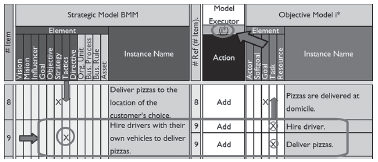
Source: Authors
Figure 3 Excerpt from the application of Matrix log in the example of the Pizza Company.
We have omitted the i* (SD) resulting model for space reasons; nevertheless in Figure 4, we show the corresponding (SR) i* model for the current case of the Pizza Company.
The figure demonstrates, for example, how the element Task in (SR) i* with Name of instance "Hire driver" (highlighted with red) (# Ref. 9) in Figure 4, and explained with more detail in the preceding paragraph, is the result of the transformation from the BMM element originated in its operational item (#9), and that corresponds to tactic "Hire drivers with their own vehicles to deliver pizzas" defined with a red circle in the Figure 3.
In addition, we can see how, for instance, # item 8 in Figure 3 describes a strategy with instance name "Deliver pizzas to the location of the customer's choice", and that also by applying the matrix mapping between constructs (Figure 1), we find a direct relation with an element i* of type Goal, which in turn, by human judgment, has been defined the instance name i*: "Pizzas are delivery at domicile". The preceding is evidenced in the Figure 4, # Ref 8.
The same alignment process is applied in the transformation of the Goal I* model to the Operational BPMN model. For instance, (highlighting some instances in red) Figure 5 displays, according to the above, how the Tasks (SR) i* "Hire driver" and "Deliver pizzas", can be transformed to a Task element in BPMN and on human judgment has retained the same instance name. This operation has taken as a reference the existing correlation according to the established definition in the Matrix mapping between constructs.
After defining the matrix log for the case of the Pizza Company, it is possible to finish with the process of descending alignment and define the corresponding BPMN model. In this case, we apply the transformation heuristic between the i* and BPMN models, as shown in Table 2.
Figure 6 shows the basic BPMN model and the outcome of the transformation process. For instance, it is clear how Tasks "Deliver Pizzas" and "Hire driver" were transformed by applying heuristic # 3, both. Similarly it is evident how it is possible to describe in the operative model the corresponding Softgoal, in this case, defined in annotations and by human judgment, applying for these cases the new heuristics # 11(b).
Conclusions
Providing support for organizational analysis by business and motivational modeling, which includes strategic and operational alignment methods, arises as a necessity for any organization ready to optimize their processes in a BPM's context. In this work, our particular contribution has been to provide an approach of organizational alignment based on heuristic techniques. We have also contributed in the classification, definition and extension of bidirectional heuristic mapping among the motivational BMM models, objective i* and operational BPMN. Similarly, another contribution that we have made is related to the construction of new matrix type artifacts, which improve the practicality and traceability of the implemented strategic-operational procedures of alignment (Figures 1 and 2). Moreover, an additional contribution relates to the description, with an example of a practical and simple application is presented in such a way that it facilitates comprehending the approach that we have proposed. The suggested methodology is a support tool that helps both, the Information System designer and the business expert in the alignment between the strategy and the business processes required to accomplish the established motivation.
The alignment approach proposed here has been implemented already in previous works as evidenced in (Collazos, 2016; Collazos & Duarte, 2016) where in a specific case study of a technology company they have been able to do an objective strategic-operational alignment in a bidirectional way, aiding themselves with this fundamental tool for implementing a method for the evaluation of the efficiency of the organizational strategy, demonstrating that the proposed approach covers an integral methodology between strategy and operations, addressing all the levels of abstraction modeling in an EA context.
As future work, efforts can be invested in automating the alignment approach by implementing a tool that can apply the alignment in a systematic and assisted way, especially for models of greater dimensions. It is also very useful to identify specific and productive contexts, where they can validate and provide feedback on this approach that would enhance the effectiveness of the proposal.













